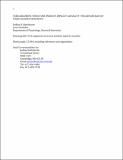| dc.contributor.author | Hartshorne, Joshua | |
| dc.contributor.author | Snedeker, Jesse | |
| dc.date.accessioned | 2014-11-19T21:19:47Z | |
| dc.date.issued | 2013 | |
| dc.identifier | Quick submit: 2014-11-12T17:12:31-05:00 | |
| dc.identifier.citation | Hartshorne, Joshua K., and Jesse Snedeker. 2013. “Verb Argument Structure Predicts Implicit Causality: The Advantages of Finer-Grained Semantics.” Language and Cognitive Processes 28 (10) (December): 1474–1508. | en_US |
| dc.identifier.issn | 0169-0965 | en_US |
| dc.identifier.uri | http://nrs.harvard.edu/urn-3:HUL.InstRepos:13403462 | |
| dc.description.abstract | While the referent of a nonreflexive pronoun clearly depends on context, the nature of these contextual restrictions is controversial. The present study seeks to characterise one representation that guides pronoun resolution. Our focus is an effect known as “implicit causality”. In causal dependant clauses, the preferred referent of a pronoun varies systematically with the verb in the main clause (contrast Sally frightened Mary because she … with Sally feared Mary because she…). A number of researchers have tried to explain and predict such biases with reference to semantic classes of verbs. However, such studies have focused on a small number of specially selected verbs. In Experiment 1, we find that existing taxonomies perform near chance at predicting pronoun-resolution bias on a large set of representative verbs. However, a more fine-grained taxonomy recently proposed in the linguistics literature does significantly better. In Experiment 2, we tested all 264 verbs in two of the narrowly defined verb classes from this new taxonomy, finding that pronoun-resolution biases were categorically different. These findings suggest that the semantic structure of verbs tightly constrains the interpretation of pronouns in causal sentences, raising challenges for theories which posit that implicit causality biases reflect world knowledge or arbitrary lexical features. | en_US |
| dc.description.sponsorship | Psychology | en_US |
| dc.language.iso | en_US | en_US |
| dc.publisher | Taylor and Francis | en_US |
| dc.relation.isversionof | doi:10.1080/01690965.2012.689305 | en_US |
| dash.license | OAP | |
| dc.subject | pronoun resolution | en_US |
| dc.subject | Implicit causality | en_US |
| dc.subject | Thematic roles | en_US |
| dc.subject | Psychological predicates | en_US |
| dc.subject | Psych verbs | en_US |
| dc.subject | Predicate decomposition | en_US |
| dc.title | Verb argument structure predicts implicit causality: The advantages of finer-grained semantics | en_US |
| dc.type | Journal Article | en_US |
| dc.date.updated | 2014-11-12T22:12:32Z | |
| dc.description.version | Author's Original | en_US |
| dc.rights.holder | Hartshorne, Joshua K. & Jesse Snedeker | |
| dc.relation.journal | Language and Cognitive Processes | en_US |
| dash.depositing.author | Snedeker, Jesse | |
| dc.date.available | 2014-11-19T21:19:47Z | |
| dc.identifier.doi | 10.1080/01690965.2012.689305 | * |
| dash.contributor.affiliated | Hartshorne, Joshua | |
| dash.contributor.affiliated | Snedeker, Jesse | |


